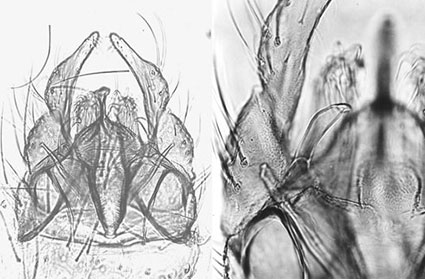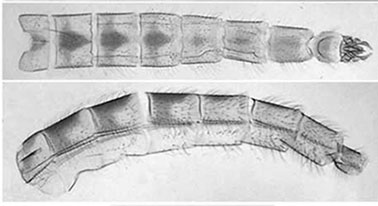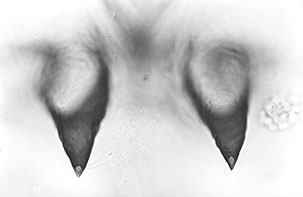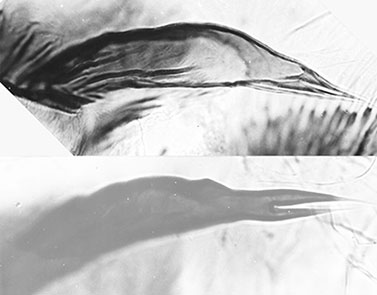Includes data from North America and Hawaii.
Male:
|
Fe
|
Ti
|
Ta1
|
Ta2
|
Ta3
|
Ta4
|
Ta5
|
LR
|
F/T
|
BR
|
PI
|
1105
|
955
|
1555
|
790
|
690
|
635
|
630
|
1.64-1.65
|
1.17
|
2-2.07
|
PII
|
1168
|
1050
|
640
|
388
|
280
|
168
|
130
|
0.59-0.63
|
1.11
|
|
PIII
|
1315
|
1215
|
993
|
518
|
405
|
260
|
160
|
0.81-0.82
|
1.08
|
|

Hypopygium (left) and Superior volsella (right) of Type 2 males from Hawaii

Male abdomen from Huntington Beach, California (Spies et al. 2002)
Abdomen with dark, posteriorly pointed, triangular area on midline with generally fairly narrow transverse band at or near anterior margin.
Female:
No confirmed specimens were available for study. Spies et al. (2002) recorded no significant variation between type 1 and type 2 individuals from different localities and also noted that there were no obvious differences from females of related species.
Pupa: Length 11.3 (9.8-13.3) mm. Cephalic tubercles well developed and dark.

Pupal cephalic tubercles
Abdominal sternite I and II with weak shagreen of variable extent, and less extensive on tergite III. Pedes spurii A of V-VII a field of small points.
Postero-lateral spur of segment VIII with usually 2-4 spines, but may be from 1-5. In a Californian specimen the 3 spines were closely applied (upper in fig. below), while in a Hawaiian pupa the 2 spines were separated like a 2-pronged fork (lower in fig. below).

Pupal spurs of Californian specimen (above) and Hawaiian specimen (below)
Fourth instar larva a small to medium plumosus-type (11.4 (9.8-13.3 mm) (male 9.8mm; female 10.3-13.3). Gula dark to very dark on posterior third to half extending beyond the width of the mentum and with a level anterior margin, Frontoclypeus also darkened, and sometimes some darkening just outside it. Ventral tubules with posterior pair longer (Ant. 1.38 (0.92-1.76) mm; Post. 1.49 (1.08-1.82 mm)), posterior pair coiled, shorter than described by Fittkau for South American specimens. Lateral tubules well developed 365 (320-420) µm). Anal tubules relatively short, ventral pair longer (dors. 336.6 (280-360) µm; ventral 384.7 (351-450) µm, about 2.4-3.7 times longer than wide.
Mentum (Fig. c) with somewhat rounded teeth; c1 tooth relatively narrow and rounded, c2 teeth moderately well separated (type IIA or III), with reduced 4th lateral (type II).
Ventromental plates (Fig. d) separated by about 29-30% of the mentum width; about 182.2 (172-195) µm long and 3.6 (3.4-3.9) times longer than deep; longer 1.08 (1.06-1.13x) than the width of the mentum; with about 40.7 (39-49) striae; VMR 0.25 (0.20-0.33).
Premandible with teeth about equal length, inner tooth about 3-4.5 times wider than outer tooth.
Pecten epipharyngis (Fig. a) with about 12.3 (10-15) somewhat irregular teeth (type B).
Distance between the antennal bases usually greater than the distance between the S4 setae, which are separated by about 81% (76-84%) of the FC width at that point.
Antenna (Fig. b) with relatively narrow basal segment, about 3.0 (2.64-3.53) times longer than wide; segment lengths (micron): 100 : 26 : 6 : 10.5 : 6 (note A3 about same length as A5; – A5/A3 0.96 (0.75-1.25)); AR about 2.15 (1.73-3.12); A2/A1 about 0.26 (0.23-0.28). Two Hawaiian specimens showed developmental abnormalities of one antenna, in one case with only 4 segments (lacking A3) and the other with only 3 segments (lacking A2 and A3).
Mandible (Fig. e) with 3rd inner tooth relatively well developed but only partly colored (mostly type IIIB, but occasionally IIB); 13 (10-15) furrows on the outer surface near the base; 11.2 (10-13) taeniae in Pecten mandibularis; MTR 0.10-0.18.
Cytology: 4 polytene chromosomes with the pseudothummi arm combination AE, BF, CD, G.
Arm G relatively long, closely paired with a nucleolus about 1/4 from end with heterochromatic cap, with a closely applied BR and two BRs near the other end. No nucleoli in other chromosomes. Moderate amount of heterochromatin at the centromeres.
Arm B with bulb and distal dark bands about 1/3 from end of arm. Polymorphism for arms A, B, and C is present in Central or South American samples and for arm C in Hawaiian samples.
cag A1: 1a-e, 9a-e, 2d-3b, 8g-d, 1k-f, 3c-i, 13-15, 4-8c, 2a-c, 10-12, 16-19
cag A2: 1a-e, 9a-e, 2d-3b, 8g-d, 1k-f, 3c-i, 13-14, 8c-4, 15e-a, 2a-c, 10-12, 16-19 ie. as sp.Villa Paz
cag A3: approx 1a-e, 9a-e, 2d-3b, 8g-d, 1k-f, 3c-i, 13a-15e, 4a, 6b-4b, 6c-8c, 2a-c, 10-12, 16-19
cag B1: Bulb and distal dark bands about 1/3 from end of arm.
cag B2: Inversion of about half of arm near distal end.
cag C1: Typical band group 3-4 about 1/3 from centromere.
cag C2: Inversion of about central half of arm, moving group 3-4 to about middle of arm.
cag E1: 1-3e, 10b-9, 3f-8, 12b-10c, 12c-13
cag F1: 1-6b, 19-18, 11f-14, 17-15, 11e-6c, 20-23 i.e. as in sp. WOC.
cagG1: Nucleolus about ¼ from heterochromatic end, with closely applied BR and two more about ¼ from other end.
Confirmed type 2 localities:
California - South Gate and Long Beach, Los Angeles River; Bellflower, San Gabriel River; N fork Coyote Creek, vicinity of Telegraph
Road, Whittier(58.97°N, 118.02°W); all Los Angeles Co.; Huntington Beach (33.640°N, 117.971°W) (type 2); Anaheim,
Santa Ana River (type 2); all Orange Co.; Good Samaritan retirement home, Corona; Hidden Valley golf course, 2 mi. w. Pedley; Valley
Seminary District, all Riverside Co.
Hawaii - Enchanted Lake, Kailaua (21.25°N, 158.67°W); Kahana Iki stream, 1.6 Km s. Kailaua (21.24°N, 158.67°W); Honolulu
(19.55°N, 154.77°W), all Honolulu County, Oahu; Kealia Pond (20.78°N, 156.93°W), Kihei, Maui.
Also Brazil - Belém (some type 2).
French Polynesia and Hawaii.
The presence of type 2 in Hawaii (and also in Tahiti from BOLD) raises a question as to the correct name for this species. The specimens were originally identified at the Museum in Honolulu as C. hawaiiensis but the cytology and BARCODE sequence place them as C. calligraphus type 2. This raises the possibility that C. hawaiiensis may be the valid name for this type. In this regard it might be noted that the descriptions of C. hawaiiensis note that some adult had anomolous development of the palps, and two these C. calligraphus larvae had a developmental abnormality of the antenna.
[ See also C. calligraphus Type 1 | C. anonymus | C. species WOC | C. hawaiiensis
| Return to Index
| Go to References ]



